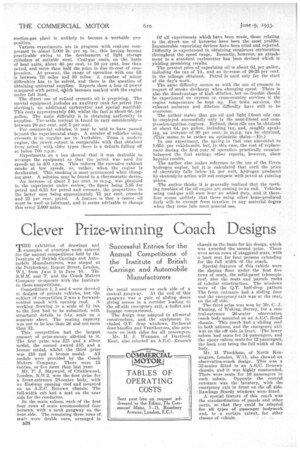Clever Prize-winning Coach Designs T HE exhibition of drawings and examples
Page 52

If you've noticed an error in this article please click here to report it so we can fix it.
of practical work entered for the annual competitions held by the Institute of British Carriage and Automobile Manufacturers, was staged at the Polytechnic, Regent Street, London, W.1, from June 5 to June 10. The S.M.M. and T. and the Coach Makers Company co-operate with the Institute in these competitions.
Competitions 1, 3 and 4 were devoted to designs of private vehicles, but the subject of competition 2 was a forward control coach with opening roof. A working drawing to a scale oflj ins. to the foot had to be submitted, with structural details to 3-in, scale on n separate sheet. The seating capacity was not to be less thau 26 and not more than 32.
This competition had the largest amount of prize-money allotted to it. The first prize was 125 and a silver medal, the second award i15 and a bronze medal, whilst the third prize was £10 and a bronze medal. All medals were provided by the Coach Makers Company. There were 15 entries, or five more than last year.
Mr. P. J. Hayward, of Cricklewood, London, N.W.2, won the first prize for a front-entrance 2S-seater body, -with an .Easiway opening roof and mounted on an A.E.C. Renown chassis. The full-width cab had a seat on the -near side for the conductor.
In the main saloon, each of the first four rows of seats accommodated four persons, with a sunk gangway on the near side. The remaining three rows of seats were double ones, arranged in
838
the usual manner on each side of a central gangway. At the end of this gangway was a pair of sliding doors giving access to a corridor leading to the off-side emergency exit, a buffet and luggage compartment.
The design was adapted to all-metal construction, and the equipment included Q.T. drop windows, I3eclawat door handles and Ventilouvres, also armrests on both sides for all passengers. • Mr. H. J. Wenmatt, of Dartford, Kent, also selected an A.E.C. Renown chassis as the basis for his design, which was awarded the second prize. There were seven rows of staggered seats, with a back seat for four persons extending for the full width of the coach.
Special features of this vehicle were the sloping floor under the first five tows of seats, the solid-panel telescopic roof, also the seats and parcels racks of tubular construction. The windows were of the Q.T. half-drop pattern The front entrance had a sliding door and the emergency exit was at the rear, on the off side.
The third prize was won by Mr. C. j. Fleming, of Woking, Surrey, for a central-entrance 26-seater observation coach body mounted on an A.E.C. Regal chassis. This coach had a sliding roof in both saloons, and the emergency exit was on the off side in front. The lower saloon had seats for 14 passengers, and the upper saloon seats for 12 passengers, the back seat being the full width of the body.
Mr. H. Tinckham, of North Kensington, London, W.11, also showed an observation-coach design. This was a 32-seater fitted to an A.E.O. Renown chassis, and it was highly commended. There were seats for 16 passengere in • each saloon. Opposite the central entrance was the lavatory, with the emergency exit in front on the off side: :Rawlings Sturdy windows were fitted. A• special feature of this coach was the standardization of panels and other parts, so that they could be adapted 1 for all .types of passenger bodywork and, to a certain extent, for other classes of vehicle.




























































































